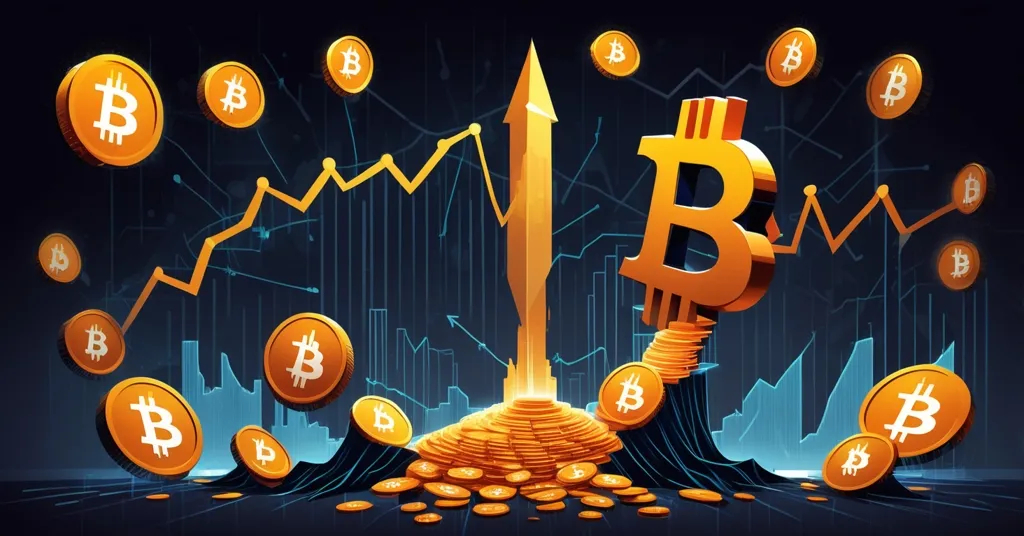Bitcoin $115K by July 2025: Real Potential or Hype? Altcoin Scams Exposed

Bitcoin $115K by July: Bold Prediction or Baseless Hype? Unpacking Drivers and Dodgy Altcoin Pitches
Bitcoin is back in the spotlight with a audacious forecast of hitting $115,000 by July 2025, fueled by economic undercurrents and whispers of crypto-friendly regulation in the U.S. Meanwhile, a trio of altcoins are being hyped as the next big buys. But is this price target grounded in reality, or just another wave of market mania? And are these altcoin picks worth a glance, or pure snake oil? Let’s slice through the noise and examine the catalysts, risks, and outright scams lurking in this speculative frenzy.
- Bitcoin’s $115K Target: Analysts speculate a massive surge by July 2025, driven by U.S. economic data and political shifts.
- Economic Factors: Weak job numbers could cool inflation fears, spurring dovish Fed policies that boost risk assets like Bitcoin.
- Regulatory Tailwind: Brian Quintenz’s nomination as CFTC chair hints at a pro-crypto regulatory shift, though hurdles remain.
- Altcoin Hype: BTC Bull Token, Best Wallet Token, and Smog Token are pitched as hot investments, but skepticism is warranted.
Bitcoin’s Road to $115K: Economic Signals and Political Plays
The buzz around Bitcoin reaching $115,000 by July 2025 has ignited excitement among investors, but let’s be clear: there’s no hard on-chain data or named expert backing this specific figure in the reports circulating. It’s a flashy number, no doubt, but without concrete evidence, it teeters on the edge of wishful thinking. That said, the underlying factors fueling this speculation—economic indicators and regulatory developments—are worth dissecting, as they’ve historically swayed crypto markets with real force. For deeper insight into what fuels such forecasts, you can explore what drives Bitcoin price predictions.
Economic Triggers: Job Data and Fed Moves
One pillar of this bullish outlook hinges on the U.S. job market. Upcoming labor reports, which gauge things like unemployment rates and job creation, could sway Bitcoin’s trajectory. If the data shows weakness—say, fewer jobs added than expected or a spike in unemployment—it might signal that inflation, the rise in prices eating away at money’s value, is cooling off. Why does this matter? A cooling economy often pushes the Federal Reserve, the U.S. central bank controlling monetary policy, to adopt a “dovish” approach. That means lowering interest rates or pumping stimulus into the system, making riskier assets like Bitcoin more attractive as investors hunt for returns beyond boring old bonds. To understand more about Bitcoin’s background and influencing factors, check out this comprehensive Bitcoin overview.
On the flip side, if job numbers come in hot, suggesting a robust economy, the Fed might slam on the brakes with higher rates to tame inflation. That typically sucks capital out of speculative markets like crypto and back into safer havens, potentially triggering a short-term dip for Bitcoin. We’ve seen this dance before—back in 2021, Bitcoin rocketed past $60,000, partly on the back of loose Fed policies post-COVID. But without specific dates for key job reports or Fed decisions tied to this $115K prediction, the forecast feels more like a gamble than a grounded analysis. Macroeconomic trends undeniably influence crypto, yet Bitcoin’s volatility means even the best-laid predictions can crash and burn on unexpected shocks—think geopolitical flare-ups or sudden policy U-turns. For a deeper dive into related economic indicators, take a look at this analysis of Bitcoin price factors.
Regulatory Hope: A Pro-Crypto CFTC?
Adding fuel to the optimism is a political development: the nomination of Brian Quintenz as chair of the Commodity Futures Trading Commission (CFTC) under a Trump administration. Quintenz, previously the global head of policy at a16z Crypto and a former CFTC commissioner, is a vocal crypto advocate with a reported $3.4 million in digital asset holdings. His bias toward the industry is clear, though it also sparks legitimate questions about conflicts of interest. His vision? Push for the CFTC, rather than the Securities and Exchange Commission (SEC), to take the lead on crypto oversight. For context, the SEC, often under hardliners like Gary Gensler, treats many digital assets as securities, slapping them with tight regulations that many argue stifle innovation. The CFTC, by contrast, could classify more tokens as commodities, offering a lighter touch that might encourage market growth. Learn more about this nomination’s potential effects in this discussion on Quintenz’s impact.
But don’t pop the champagne just yet. Quintenz’s Senate confirmation hearing isn’t until June 10, 2025, and approval isn’t a slam dunk. Plus, the CFTC is in disarray after multiple leadership departures, meaning a fully pro-crypto commission might not coalesce until 2026. Broader U.S. policy trends—like bipartisan crypto bills or state-level experiments—add layers of complexity, and opposition in Congress could stall any regulatory green light. Global angles matter too; Europe’s MiCA framework is setting strict but clear rules, while El Salvador’s Bitcoin-as-legal-tender experiment keeps pushing boundaries. So, while Quintenz’s nomination is a potential tailwind for Bitcoin and the industry, it’s far from a done deal. Could this be the regulatory breakthrough crypto needs, or just another mirage on the horizon? For further details on the nomination process, see this update on Quintenz’s CFTC role.
The Bullish Case and Sobering Risks
Let’s play devil’s advocate and explore why some might see $115K as feasible, even if I remain skeptical. Bitcoin’s history offers clues—post-halving bull runs are a recurring theme. A halving, for the unversed, cuts the reward miners get for adding new blocks to the blockchain roughly every four years, slashing new Bitcoin supply and often igniting price surges due to scarcity. After the 2016 halving, Bitcoin soared over 300% within 18 months. The 2020 halving preceded a climb to $69,000 by late 2021. With the 2024 halving in the rearview, 2025 could indeed be a peak year if patterns hold. Add to that growing institutional adoption—think corporations like MicroStrategy stacking Bitcoin in their treasuries—and metrics showing steady wallet growth, and you’ve got a recipe for optimism. Join the ongoing conversation about this prediction in this Reddit thread on Bitcoin’s $115K forecast.
Yet, here’s the cold water: history isn’t destiny. Bitcoin’s price is a rollercoaster, prone to brutal corrections—drops of 50% or more aren’t rare. On-chain data like whale accumulation (big investors scooping up BTC) or network activity isn’t cited in this $115K forecast, leaving it hollow. Macro risks loom large—persistent inflation could force Fed rate hikes, geopolitical tensions might spook markets, and miner sell-offs could dump supply at the worst time. Bitcoin remains a beacon of decentralized money, a middle finger to fiat debasement, but pinning a precise target like $115K without robust evidence is reckless at best. The potential is there; the certainty is not. For a broader perspective on this bold claim, explore this report on Bitcoin hitting $115K by July.
Altcoin Hype: Hidden Gems or Blatant Scams?
While Bitcoin’s lofty forecast steals headlines, it’s also stoking a feeding frenzy around altcoins pitched as complementary bets for the next bull run. Three tokens—BTC Bull Token ($BTCBULL), Best Wallet Token ($BEST), and Smog Token ($SMOG)—are being touted as prime picks. Each comes with shiny promises, but scratch the surface, and you’ll find warning signs galore. Let’s dissect these projects, balancing their supposed appeal with the harsh realities of presale pitfalls and outright fraud allegations.
BTC Bull Token ($BTCBULL): Bitcoin Dreams or Nightmare?
Priced at $0.00255 during its presale, BTC Bull Token has reportedly raised over $6.8 million with a gimmick that’s catnip for Bitcoin fans: holders earn BTC rewards when Bitcoin hits milestones like $150,000, while token burns—destroying part of the supply to potentially boost value—kick in at levels like $125K, $175K, and $225K. Sounds like a neat way to ride Bitcoin’s coattails, right? Wrong. Community feedback on platforms like Reddit paints a grim picture. Users report tokens vanishing after purchase, support emails going unanswered, and confusion over duplicate websites (btcbull.io vs. btcbulltoken.com). Some call it a straight-up scam, with associated wallets showing shady pricing tricks. No verifiable team info or audited smart contracts? That’s a neon sign screaming “rug pull.” If Bitcoin’s ethos is trustlessness, this project is a betrayal of that ideal. Hard pass until proven otherwise. For more community insights, check this Reddit discussion on BTC Bull Token.
Best Wallet Token ($BEST): Utility or Deception?
Next is Best Wallet Token, priced at $0.025135 in presale, with a claimed $13.1 million raised. Tied to the Best Wallet Web3 app, it promises utility—think reduced fees, staking rewards, and access to new crypto presales—positioning itself as a MetaMask rival. With over 70,000 followers, the hype seems real. But hold your horses. Reddit threads link “Best Wallet” to scams involving $BTCBULL, with users alleging manipulative pricing, like valuing Bitcoin at $1,925 when selling for USDT. Whether $BEST is directly implicated isn’t certain, but guilt by association stinks. Web3 apps can empower users by decentralizing asset management, but when the ecosystem reeks of fraud, that vision crumbles. Those $13.1 million figures? Unverified. Without proof, this looks like another trap for the hopeful. Proceed with extreme caution.
Smog Token ($SMOG): Meme Coin Mania or Mild Promise?
Lastly, there’s Smog Token, a dragon-themed meme coin priced at $0.008897, operating on both Solana and Ethereum blockchains. With a 1.4 billion token supply, 35% is earmarked for airdrop rewards to engage its community. Meme coins thrive on hype, especially during bull markets, and a multichain setup—tapping Solana’s speed and Ethereum’s vast user base—could give it traction. Unlike the other two, there’s no glaring scam evidence in community chatter, but let’s not kid ourselves: meme coins are speculative gambles, often crashing as fast as they spike. They’re less about utility and more about viral buzz. Still, for folks who see altcoins filling playful niches Bitcoin ignores, $SMOG is the least offensive here. That’s a low bar, though—tread lightly.
Presale Pitfalls: A Systemic Problem
All three projects wave the “do your own research” (DYOR) flag, and for damn good reason. Presales are the Wild West of crypto—rife with scams, pump-and-dumps, and shattered dreams. Why? Lack of transparency, unaudited code, and often anonymous teams mean there’s little accountability. While I lean Bitcoin maximalist, I’ll acknowledge altcoins and other blockchains like Ethereum or Solana can drive innovation and accessibility in ways Bitcoin doesn’t. But when projects like $BTCBULL and $BEST are drowning in fraud allegations, they’re not advancing decentralization; they’re preying on greed. If you’re tempted, here’s a tip: check for audited contracts, public team info, and real community feedback before throwing money at these black holes. Better yet, stick to proven assets until the smoke clears. For a detailed guide on spotting such risks, see this resource on altcoin presale scams.
Bitcoin, Altcoins, and the Fight for Financial Freedom
Whether Bitcoin surges to $115K or not, this saga underscores crypto’s deepening ties to global systems—economic policies, regulatory battles, and speculative fervor. Bitcoin stands as a defiant hedge against fiat uncertainty, a tool for personal sovereignty in a world of centralized control. Its potential to disrupt the status quo aligns with effective accelerationism—pushing tech and freedom forward at breakneck speed. Altcoins, for all their flaws, sometimes carve out niches Bitcoin doesn’t touch, from smart contract ecosystems to community-driven memes. Yet, the dark side—scams, hype, and predatory projects—threatens to undermine the trustless vision we’re fighting for.
The economic and regulatory pieces of this puzzle deserve your attention. Weak job data or a dovish Fed could indeed juice risk assets, while Quintenz’s nomination hints at a future where crypto isn’t suffocated by red tape. But baseless price targets and dodgy altcoins? They’re distractions at best, dangers at worst. Bitcoin’s journey isn’t about quick riches; it’s about building a financial system that doesn’t bow to bloated institutions. Stack sats if you believe in that future, but keep your wits sharp. The road to decentralization is paved with both promise and peril.
Key Questions and Takeaways for Crypto Enthusiasts
- What’s behind the $115K Bitcoin prediction for July 2025?
The forecast rests on weak U.S. job data potentially easing inflation and prompting Fed stimulus, plus regulatory optimism from Brian Quintenz’s CFTC nomination, though solid evidence for this exact target is absent. - How realistic is the regulatory boost from Quintenz’s nomination?
It’s promising but delayed—his pro-crypto leanings and CFTC focus over SEC control could help, but his confirmation isn’t until June 2025, and agency flux might push real change to 2026. - Are altcoins like $BTCBULL, $BEST, and $SMOG worth considering?
Unlikely—$BTCBULL and $BEST face serious scam accusations, from missing tokens to shady pricing, while $SMOG’s meme coin status makes it a high-risk bet; DYOR is non-negotiable. - Can Bitcoin’s potential overshadow altcoin dangers?
Not entirely—Bitcoin’s decentralized promise is compelling, but altcoin presales often exploit bull run hype; prioritize fundamentals over unproven tokens promising overnight gains. - How can investors shield themselves from altcoin scams?
Verify team credentials, demand audited smart contracts, scour community feedback on platforms like Reddit, and avoid projects lacking transparency—when in doubt, stick to established assets. - What historical patterns support or challenge a 2025 Bitcoin bull run?
Past halving cycles (2016, 2020) fueled massive rallies, and institutional adoption grows, but volatility, macro shocks, and regulatory delays could easily derail a $115K run without warning.



